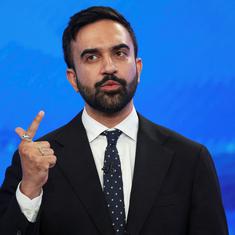It is in this light that we must examine the flurry of activity in the usually sedate world of academic history since the Modi government assumed power on May 16. Most recently, the Akhil Bhartiya Itihas Sankalan Yojana, a historical research organisation with ties to the Rashtriya Swayamsevak Sangh, held a symposium to celebrate Hemu, the so-called last Hindu king of Delhi, who controlled the city with his Afghan forces for 29 days before Akbar’s regent retook it. Yet, like much of Hindutva history, the core facts of the argument were simply made up. To give one rather hilarious example: at the symposium, scenes from the Bollywood movie Jodhaa Akbar were screened as part of a “documentary” on the period.
Medieval history has already been communalised
The ABISY might have made a hash of things, but it must be noted that at the popular and political level, the object of politicising medieval history has already been realised. The project to slowly devalue the contribution of the medieval – Muslim – rulers is on in earnest. Delhi and Agra may have been the capitals of the vast Mughal Empire, but the dynasty is slowly being excised from the memories of both cities.
The internet is packed with rants about roads named after Mughals and other Muslim rulers, but the fact is that the chosen nomenclature in independent India has scrupulously avoided medieval Muslim monarchs: Aurangzeb Road, Akbar Road and so on are parting gifts bequeathed by the British builders of Lutyens’ Delhi. In Lucknow there is a road named after Maharana Pratap of Mewar, but Wajid Ali Shah, the tragic last nawab of the city, has been ignored by Lucknow’s civic planners.
Recent history
The real fight is over more recent history. The attacks on Jawaharlal Nehru, whose liberal policies make him a special hate figure in the Sangh Parivar, seem to be coming from every corner. Modi set this particular ball rolling, arguing during his Lok Sabha campaign that Patel would have made a better Prime Minster than Nehru, echoing his guru, MS Golwalkar, who greatly admired the Sardar as well.
British historians first communalised medieval Indian history, categorising eras as “Hindu” and “Muslim”, but the project to rewrite the modern period is more recent, and more difficult. Hence the confused assertions about Nehru, Patel and the nature of their relationship.
India’s potential new icons
The destruction of old icons demands the elevation of new ones. This government’s first Budget had social schemes named after right wing stalwarts such as Shyama Prasad Mukherjee, Deendayal Upadhyaya and Madan Mohan Malaviya. All three are relatively unknown in the popular discourse but hold special significance to the Bharatiya Janata Party and the Hindutva movement.
Shyama Prasad Mukherjee was the founder of the Bharatiya Jana Sangh, a party he started with the backing of the RSS in 1951, after falling out with Nehru. He persuaded the RSS to involve itself directly in political affairs. Till then the RSS had avoided politics, preferring to direct its energies towards Hindu society instead. The BJP is the direct successor of the Jana Sangh. The BJP still draws much of its ideological mooring from Mukherjee – see its position on Article 370 – though it ignores the fact that he was party to the disastrous decision to refer Kashmir to the United Nations.
Organisationally, however, Mukherjee had limited impact on the Jana Sangh since he died within two years of its founding. After that, Deendayal Upadhyaya took up the task of building the Jana Sangh, playing a seminal role in shaping the party’s ideology. His philosophical tract, Integral Humanism, still has a key impact on the BJP, even being named in several manifestos. Upadhyaya lays out the Hindutva view of India, rejecting individualism and even capitalism, both of which he characterised as Western imports alien to India. He supported an “organic” form of the caste system which he felt would lead to a harmonious society. His social agenda has survived more or less intact in the BJP till this day.
Madan Mohan Malaviya was actually the Congress president on two occasions (1910 and 1918), but like Patel, Malaviya’s religious and social conservatism endears him to today’s BJP. He was also one of the early leaders of the Hindu Mahasabha, which during his time functioned as a Hindu nationalist pressure group within the Congress (it would delineate itself as an independent party in the late 1930s under the leadership of Vinayak Damodar Savarkar). Malaviya founded the Banaras Hindu University with the aim of upholding Hindu tradition, including a hereditary caste system, even as he strongly opposed untouchability, correlating it to Muslim and Christian conversion, a strain of thinking which strongly influences the Hindu Right.
Fair or not, Nehru, Mahatma Gandhi and then Indira and Rajiv Gandhi have dominated India’s post-Independence story, and the Congress has tried to cement its rule with help of these icons. With the verdict of May 16, a realignment of the historical stars is on the horizon. Already, the BJP’s chief Twitter intellectual Subramaniam Swamy, never one to miss a chance at medievalism, has called for the books of Nehruvian historians to be “burnt in a bonfire”.
“It is important to resize the stature that Nehru enjoys in Indian history,” said Swamy in an op-ed in The Hindu. Slowly the BJP will push its own icons to replace the old Nehruvian ones. This will include fellow ideological travellers such as Vallabhbhai Patel, Madan Malaviya, Dayanand Saraswati and Swami Vivekananda, but will also incorporate leaders as SP Mukherjee and Deendayal Upadhyaya.










